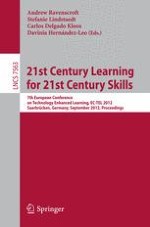This book constitutes the refereed proceedings of the 7th European Conference on Technology Enhanced Learning, EC-TEL 2012, held in Saarbrücken, Germany, in September 2012.
The 26 revised full papers presented were carefully reviewed and selected from 130 submissions. The book also includes 12 short papers, 16 demonstration papers, 11 poster papers, and 1 invited paper. Specifically, the programme and organizing structure was formed through the themes: mobile learning and context; serious and educational games; collaborative learning; organisational and workplace learning; learning analytics and retrieval; personalised and adaptive learning; learning environments; academic learning and context; and, learning facilitation by semantic means.
